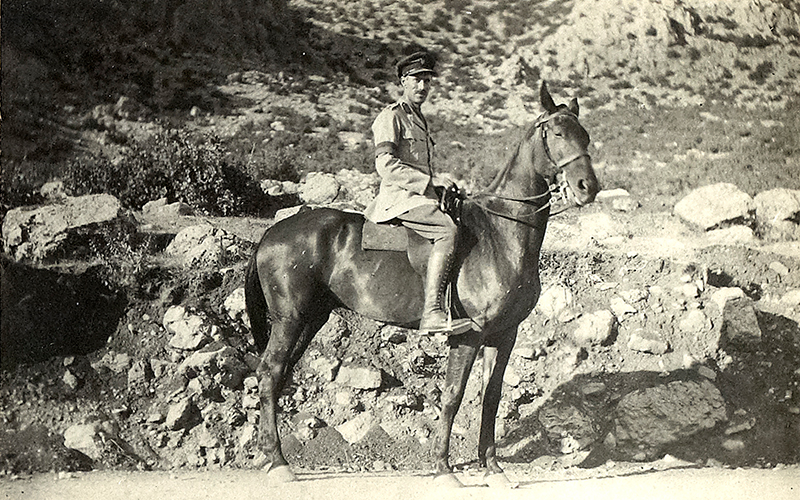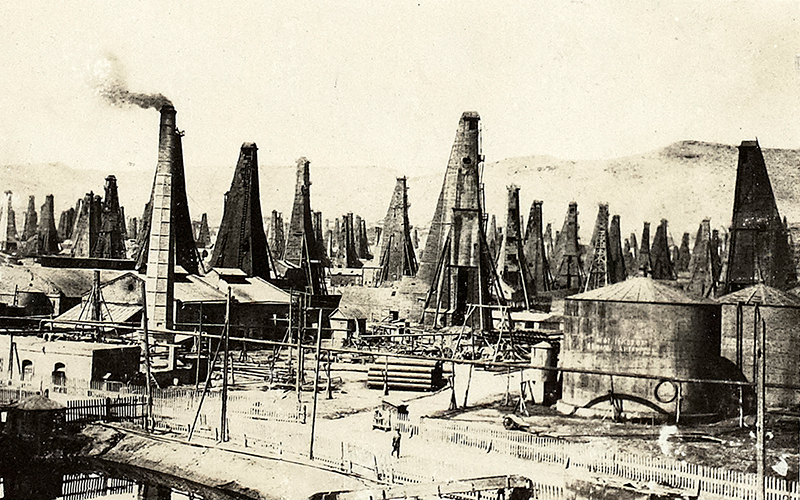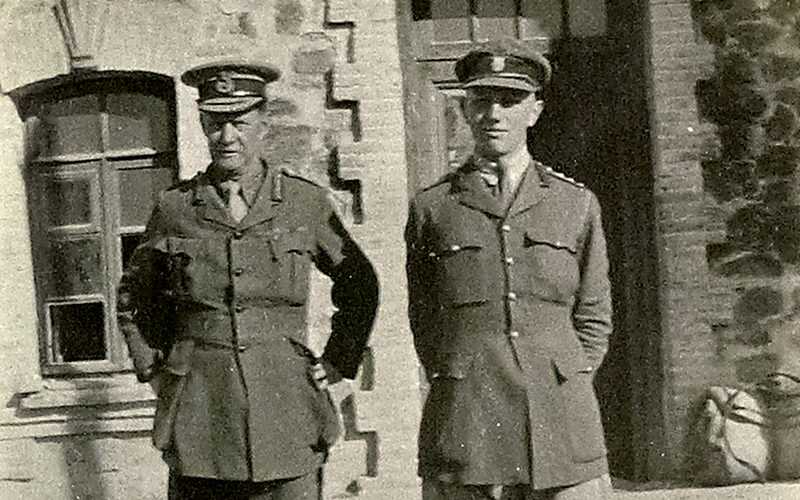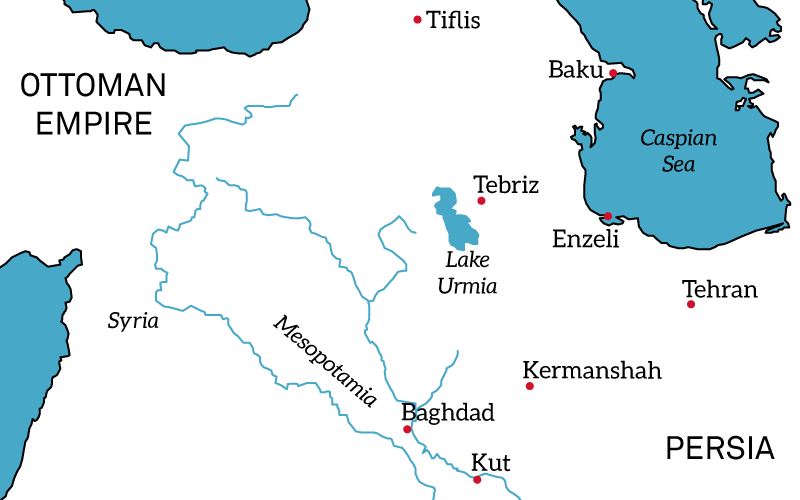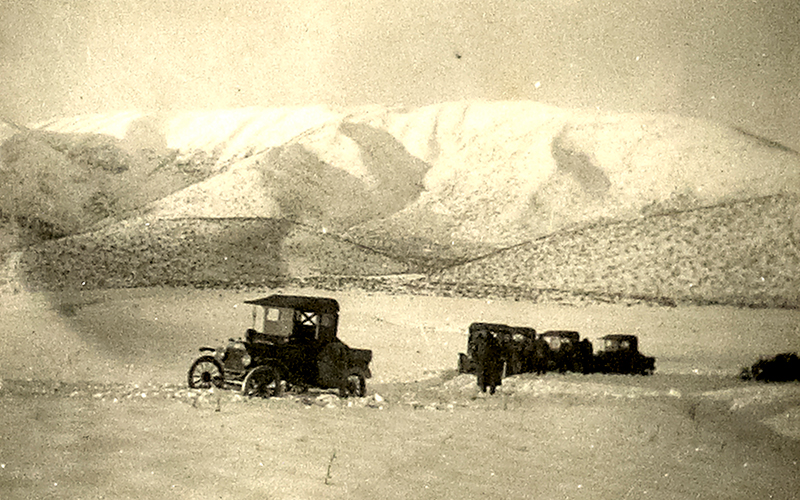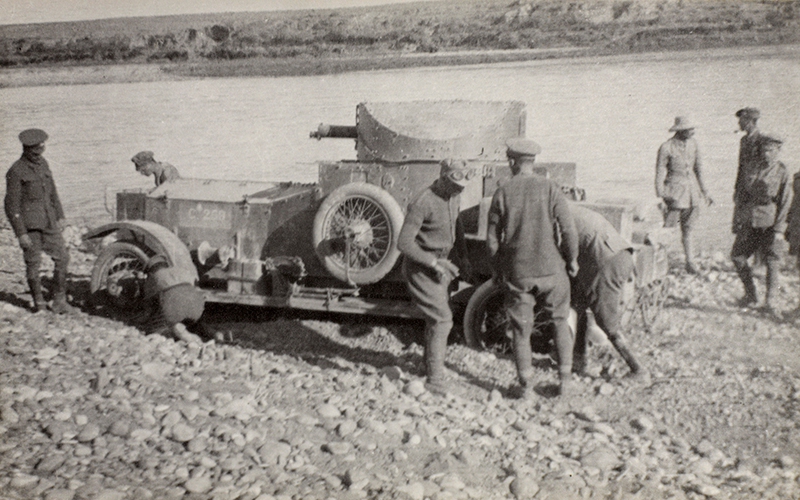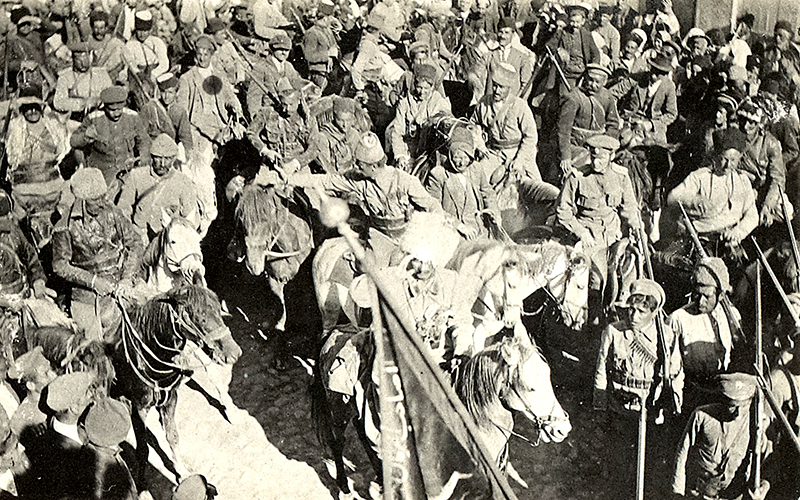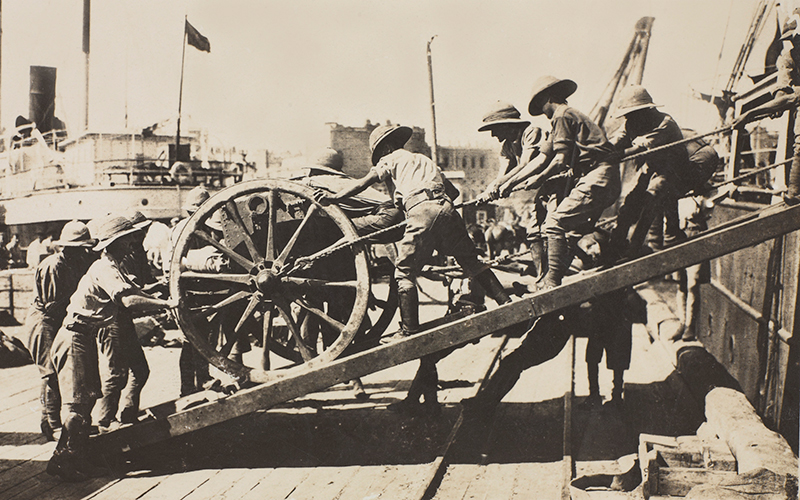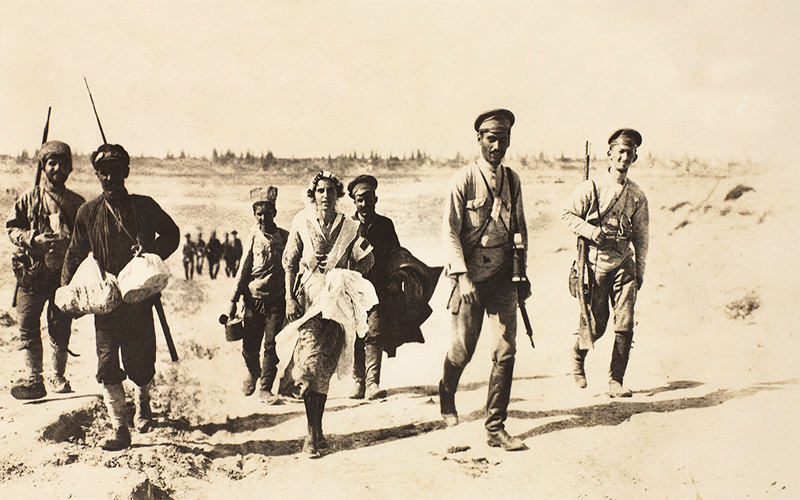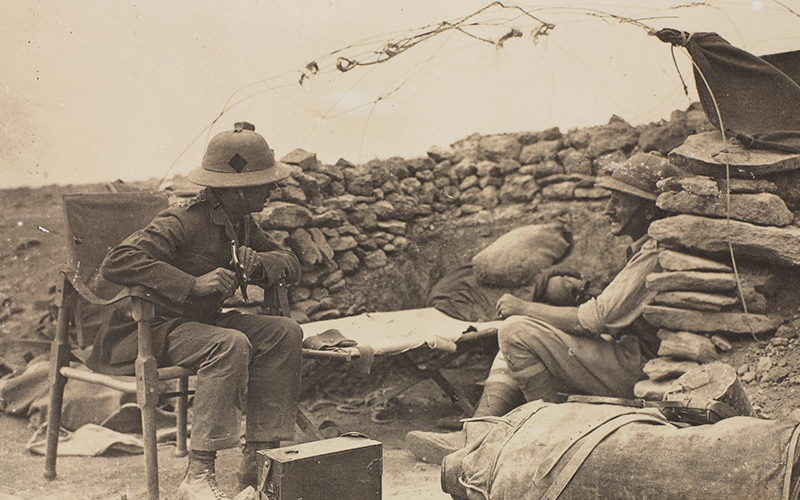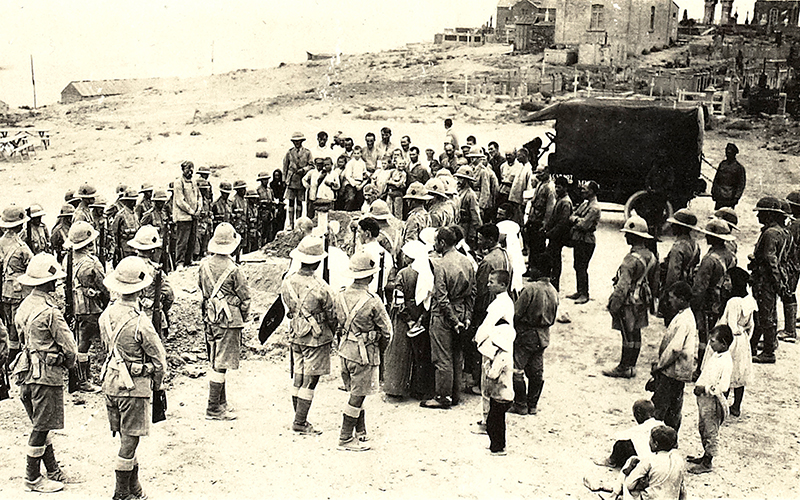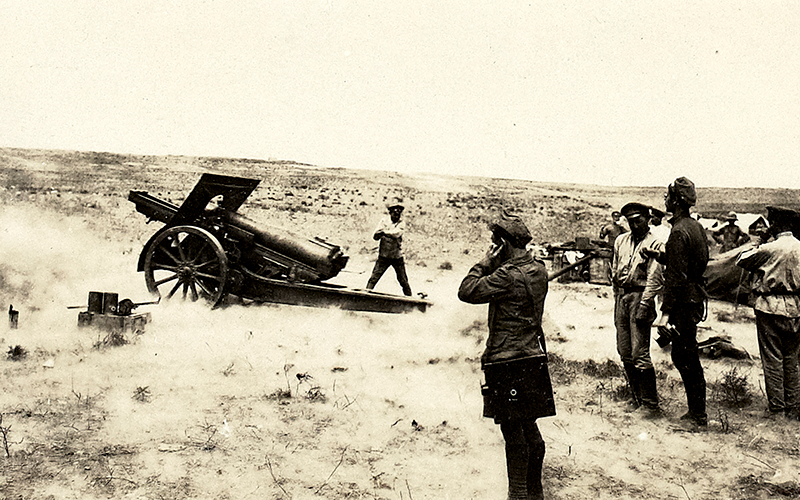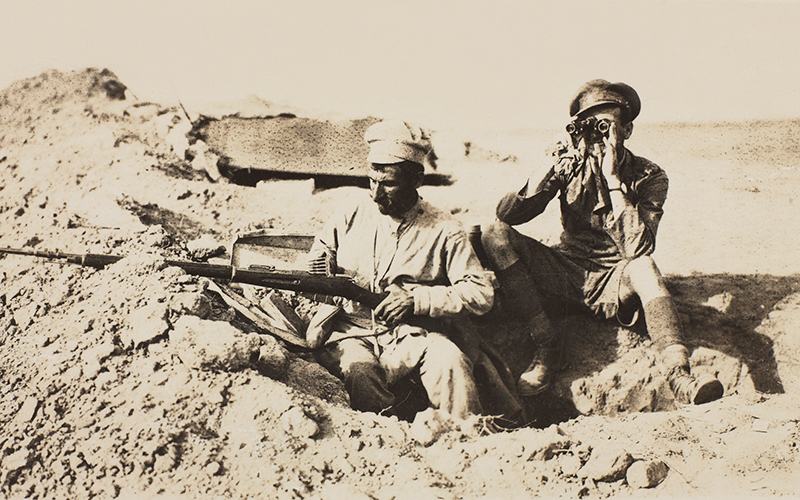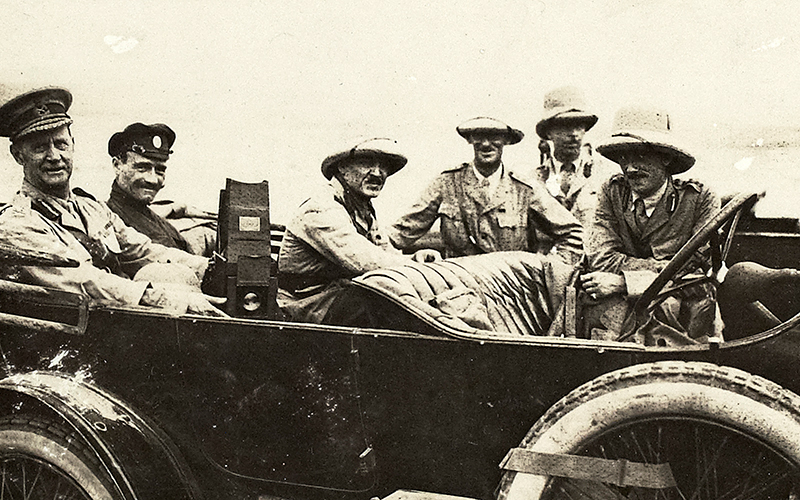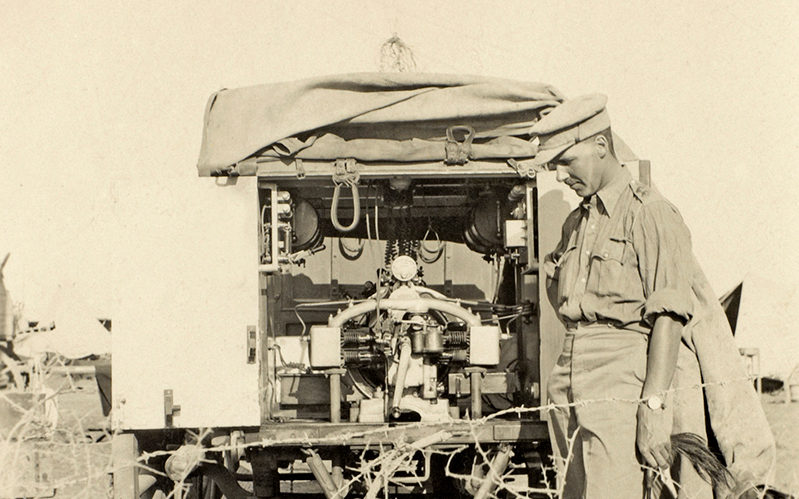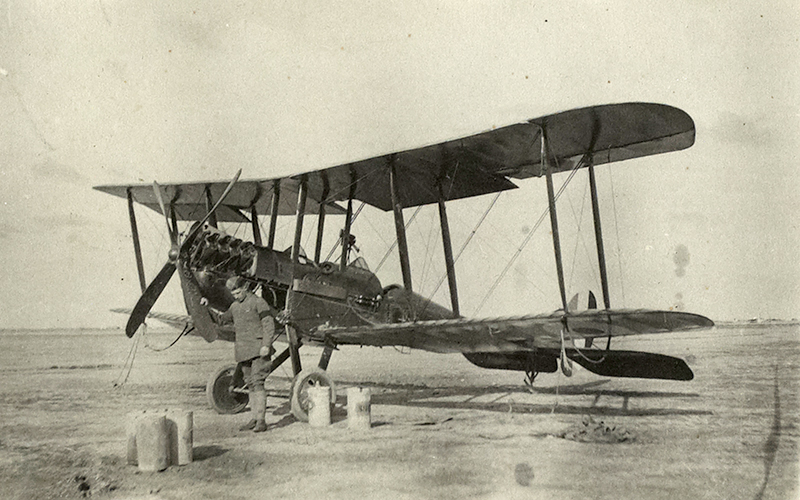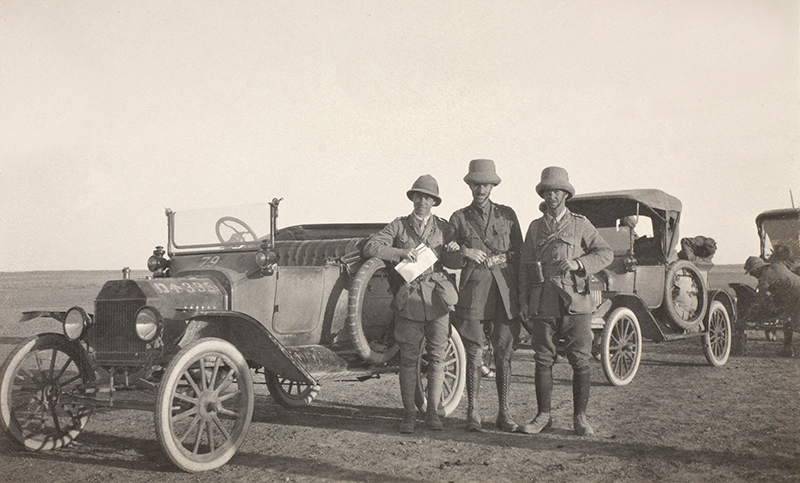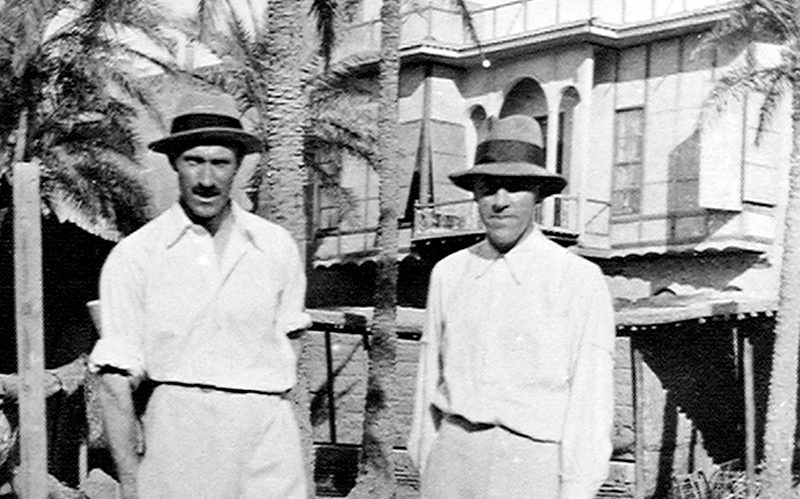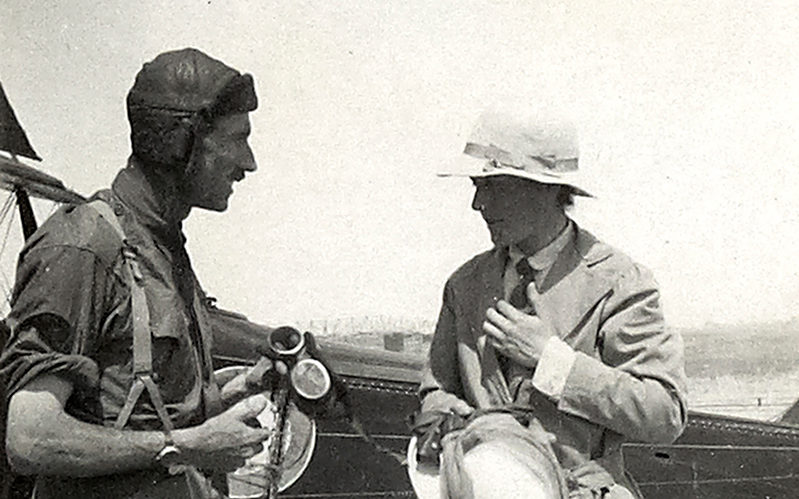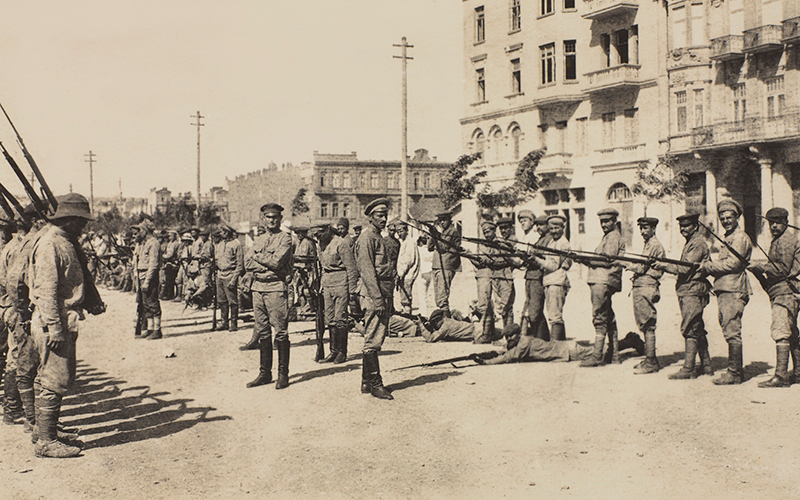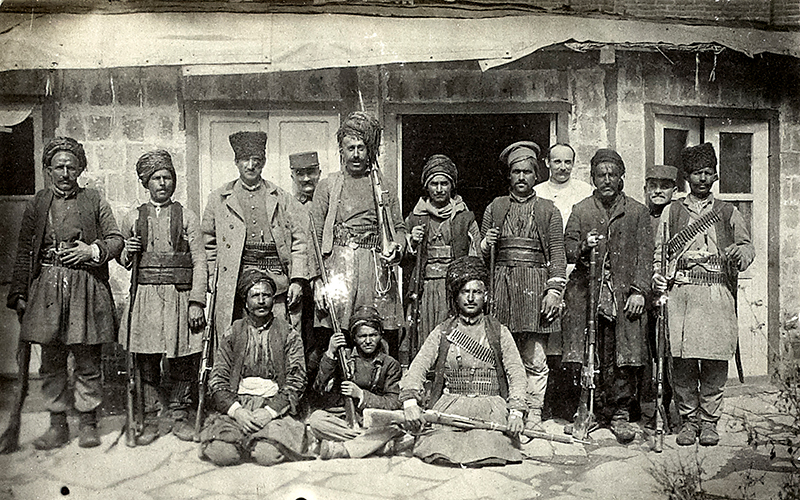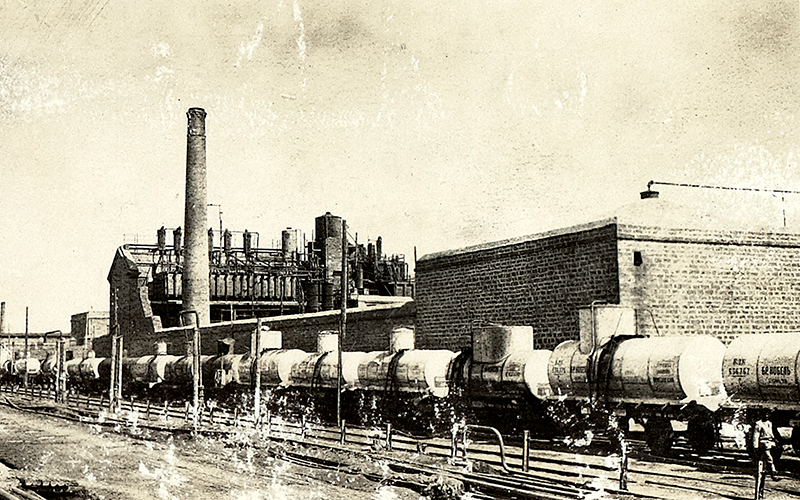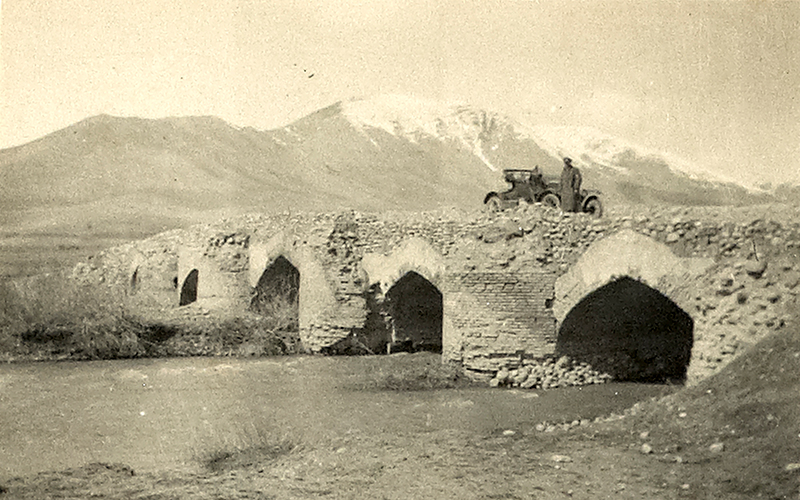In January 1918, the British assembled a prototype special operations unit known as Dunsterforce. This handpicked team of soldiers undertook a daring secret mission to northern Persia (now Iran) and the Caucasus. Their aim was to unify into an effective force the various anti-Bolshevik and anti-Turkish groups fighting there. The photographs and papers of Captain William Leith-Ross, a member of Dunsterforce, shed light on this largely unknown episode.
Crisis in the Caucasus
After the Bolsheviks seized power in Russia during the October Revolution (1917), the Russian armies opposing the Turks on the Caucasian Front began to disintegrate. The British therefore felt it necessary to bolster the Allied position there.
Dunsterforce, named after its commander Major-General Lionel Dunsterville, was tasked with securing the vulnerable oil installations at Baku and the strategically important Trans-Caucasian railway from both the Turks and the Bolsheviks. Such a move would also secure the right or eastern flank of the British forces fighting in Mesopotamia, now exposed following the Russian withdrawal.
This was all to be achieved by organising local groups of Armenians, Assyrians, Georgians and anti-Bolsheviks into an irregular army.
Dunsterville even had the authority to encourage the establishment and maintenance of independent friendly nations, such as Georgia and Armenia, in order to stabilise the Caucasus and simultaneously help safeguard the approaches to British India from any possible Turkish attack. This was deemed a real threat given Turkish intentions to expand their influence both in the Caucasus and further eastwards.
More details: NAM. 1983-12-71-128
Special ability
Dunsterforce, officially called the British Military Mission to the Caucasus, consisted at its peak of around 1,000 officers and non-commissioned officers. They were selected from across the British Empire, including men serving on the Western Front and in the Middle East.
One officer wrote of an emphasis on ‘strong character, and adventurous spirit, especially good stamina, capable of organising, training and eventually leading, irregular troops’. (Cited in Timothy C Winegard, ‘Dunsterforce: A case study of coalition warfare’, in Canadian Army Journal, Vol 8.3 Fall 2005, p100)
Dunsterville himself stated:
‘All were chosen for special ability, and all were men who had already distinguished themselves in the field. It is certain that a finer body of men have never been brought together.’
A British artillery officer with Armenians at a forward observation post, Baku, September 1918
More details: NAM. 1983-12-71-161
Advance party
The men recruited from the Western Front sailed from London on 29 January 1918 and arrived in Baghdad on 20 March. But growing worries about the chaotic situation in the Caucasus had already forced the British to send ahead a small advance party on 27 January 1918.
Dunsterville, Leith-Ross and 50 other men were ordered to head north to secure Baku and then, if possible, move to Tiflis (now Tbilisi) where they were to establish a base for recruiting and directing irregular forces. They took with them a large amount of Persian silver and British gold to assist this plan.
Stopped at Enzeli
Driving cars, vans and armoured vehicles, they travelled over 300 miles north-east through difficult Persian terrain, over the 7,600-feet Asadabad Pass, down to Hamadan, and then north another 250 miles to Enzeli (now Bandar-e Anzali) on the Caspian Sea. En route, this small force was bolstered by a group of anti-Bolshevik Cossacks whom they encountered at Kermanshah.
At Enzeli they hoped to obtain ship passage to Baku. But, arriving on 19 February, they found the port controlled by hundreds of armed Bolsheviks and other revolutionaries. The message they received was that Russia was no longer at war with the Turks, and the British were not wanted there.
Ford vans struggling through deep snow in the high Persian passes, 1918
More details: NAM. 1983-12-71-76
Hearts and minds in northern Persia
Dunsterville returned to Hamadan, arriving on 25 February 1918. His group now stayed there until the summer. They spent the next few months engaged in famine relief work and civil construction projects.
Many locals resented the presence of foreign soldiers in Persia as earlier depredations by the Turkish and Russian armies had contributed to widespread starvation. The Dunsterforce aid effort bolstered the reputation of the British in what was officially still a neutral country.
Dunsterforce officers also trained the locals so that they could defend their villages from bandits and Turkish-backed tribesmen. Members of the group engaged in several skirmishes with the latter and helped deny the movement of enemy agents through north-west Persia.
Digging out a Dunsterforce armoured car after a river crossing, 1918
More details: NAM. 1983-12-71-105
Urmia crisis
In July 1918, Dunsterville also sent a small force with money and arms to assist the Jelus, a group of Assyrians resisting the Turks around Lake Urmia to the north-west. Leith-Ross recorded that:
‘[The Assyrians] were forced to evacuate their own country in the 1915 summer. After this they were armed and are now generally spoken of as “Jelus”. We sent them thousands of rifles and much ammunition. It was very difficult to get it to them across country.’
But when the British group arrived they found the town of Urmia captured by the Ottoman army. About 80,000 people fled and the Dunsterforce party helped hold off the Turkish pursuit and attempts by Muslim Kurdish tribesmen to attack the refugees.
Eventually they reached safety near Hamadan, where a brigade-sized force was later raised from the survivors, trained and commanded by a small Dunsterforce detachment. The remaining Assyrian refugees were sent on to refugee camps near Baghdad.
Assyrian troops led by Agha Petros (saluting) with a captured Turkish banner in the foreground, 1918
More details: NAM. 1983-12-71-189
During this episode the British found it difficult to work out who among the myriad tribes and faiths in the region were allies or enemies. Leith-Ross noted that one Kurdish group he met, called the Shekoik, ‘fought with the Christians against the Shiah Moslems, but later they proved traitors and were shot’.
To Baku
During May-June 1918, the London contingent and extra infantry and cavalry detachments had joined Dunsterville at Hamadan. They had travelled from Baghdad by train part of they way before being forced to march with mules the remaining 200 miles. Now reinforced, Dunsterville returned to Enzeli, which was finally occupied on 27 June. He then set sail for Baku in early July.
By the time Dunsterville disembarked in Baku, the city was already under siege by the Turkish army. For the next six weeks his men struggled to bolster the 7,000 Armenian, Assyrian and Russian volunteers (including some Bolsheviks) defending the port.
Dunsterforce tried training the troops into an army, but found them commanded by five different political factions, making control and coordinated action difficult.
More British reinforcements arrived, including troops from 39th Infantry Brigade and two Royal Air Force Martinsyde fighter-bombers. But the local forces frequently melted away when attacked or failed to follow orders. Leith-Ross noted that during one engagement ‘the Armenians instead of holding on to the Binagardy position fled at the first attack’.
He also witnessed Armenian women fighting in the trenches:
‘There were many women who did this, for they had lost their homes and had nowhere else to go. They preferred to take their chances with their own men, rather than remain behind unprotected’.
On 1 September 1918, large Turkish regular forces and Muslim tribesmen launched co-ordinated offensives against both Baku and Hamadan. Baku fell on 14 September.
Dunsterville evacuated his force back to Enzeli and then Hamadan, leaving 180 soldiers dead or captured. He was accompanied by thousands of Armenian refugees.
More details: NAM. 1983-12-71-166
Judging the missions
Luckily, the Turks greatly overestimated Dunsterforce’s strength. Once it was back in northern Persia they suspended their drive from Tabriz towards Hamadan. This provided some security to the right flank of the British forces in Mesopotamia, one of the original goals of the mission.
The War Office disbanded Dunsterforce on 22 September 1918. Most of the surviving men returned to their original units.
The resources available to Dunsterville, both in terms of men and equipment, were insufficient to accomplish the mission’s main goals of holding oil-rich Baku before advancing to Tiflis or securing the railway network. The British also struggled to mobilise the residents of Baku, who were too preoccupied with infighting to mount a united defence.
An Armenian howitzer fires at enemy positions near Baku, September 1918
More details: NAM. 1983-12-71-162
Despite this, Britain’s wartime prime minister David Lloyd George believed Dunsterforce succeeded in keeping the Ottomans and Germans from acquiring much-needed oil for six crucial weeks in August and September 1918. This was a period in which the war was decided by victories over Germany on the Western Front, and defeats of the Ottomans in Mesopotamia, Palestine, and Salonika.
On 30 October 1918, the Ottoman Empire signed the Armistice of Mudros with the Allies, so its occupation of Baku and the oilfields was short lived.
Special Force
They may not have achieved all their objectives, but the men of Dunsterforce exhibited the kind of courage and endurance that we often associate with Special Forces missions.
In northern Persia and the Caucasus the conditions in which they travelled and fought were extreme. Marches of up to 30 miles per day in temperatures topping 50C, or plummeting to -40C in the mountain passes, were routine.
They were cut off from immediate reinforcements and lacked a reliable supply line. It also took great skill to drive and maintain a column of basic motor vehicles across such terrain. The men of Dunsterforce were often treated as unwelcome strangers in lands wracked by famine, war, genocide, and civil unrest. But they tried to work with local groups against a common enemy.
More details: NAM. 1983-12-71-167
Biography
William Leith-Ross (1884-1960) was born on 14 November 1884 at Meerut in India. He was the son of John Leith-Ross, laird of Arnage Castle near Ellon in Aberdeenshire, and Frances Forbes Lamond. He had one brother, John, and a sister, Elena Violet.
After completing his education, William was commissioned as a second lieutenant on the Indian Army’s Unattached List in January 1904 and posted to 2nd Battalion The North Staffordshire Regiment in Dugshai. The following year he joined the 77th Moplah Rifles in Bangalore and was also appointed an extra aide-de-camp to the Prince and Princess of Wales during their visit to India.
In 1907 Leith-Ross’s regiment was disbanded. After commanding the escort to the Colours as they were laid up in St Mark’s Cathedral, Bangalore, he was posted to 55th Coke’s Rifles (Frontier Force) in October. The 55th were stationed on the North West Frontier and in April-June 1908 Leith-Ross took part in the Mohmand Expedition against one of the region’s rebellious tribes.
He married Elizabeth Martin Stewart in 1914 and the couple had two children, Jean Leith and Doreen Stewart.
The 55th remained on the frontier during the First World War, but many men from the regiment saw service abroad while attached to other units. Captain Leith-Ross went to France in October 1914 with 57th Wilde’s Rifles (Frontier Force) where he served as a company commander and then a staff officer at the Ferozepore Brigade headquarters. He was present at La Bassée (1914), Messines (1914), Givenchy (1914), Neuve Chapelle (1915) and the Second Battle of Ypres (1915).
Captain William Leith-Ross next to a wireless wagon station, c1916
More details: NAM. 1983-12-72-165
In early 1916, Leith-Ross was attached to the intelligence staff of the Indian Expeditionary Force’s headquarters in Mesopotamia. One of his first major tasks was assisting Tigris Corps with the doomed attempt to relieve the besieged British-Indian force at Kut.
Despite this setback, he continued his intelligence duties, producing many reports for the British high command, such as ‘The physical and climatic difficulties of the Mesopotamian theatre’, in August 1916.
The role gave him a unique opportunity to travel by motor vehicle and aircraft to reconnoitre, photograph, survey and report on the British area of operations. This resulted in two remarkable albums of photographs now in the museum’s collection. Some of these were official photographs collected by Leith-Ross, but he personally took many more.
More details: NAM. 1983-12-72-200
His papers are also full of reports that reveal the nature of his work at this time, including ‘Publicity and propaganda’, ‘Character and qualifications of intelligence personnel’, ‘The control and safeguarding of codes and ciphers’, ‘Reports on advanced air-photo compilation’, ‘Leakage of information through prisoners of war’ and ‘Function of wireless in war and its value as a source of information’.
In March 1917, Leith-Ross took part in the Jezireh Reconnaissance. He later noted:
‘I was ordered to carry out this reconnaissance (which lasted six days) to find out whether, by making use of some of the ancient canals (now all dry) it would be possible to divert Euphrates water into the Tigris near Ctesiphon. The Tigris was then very low and the main object of the scheme was to raise its level to admit of all our river steamers getting up-river without grounding’.
More details: NAM. 1983-12-70-116
His intelligence experience, and the fact that he was already in theatre, made Leith-Ross an ideal recruit for Dunsterforce. He was seconded to Dunsterville in January 1918.
Leith-Ross was gazetted full captain on 3 June 1918 and awarded the Military Cross (‘The London Gazette’, 26 August 1918) for his exploits in the Caucasus. He subsequently returned to his intelligence duties with the Expeditionary Force, remaining in Mesopotamia until the end of the war.
A keen tennis player, Leith-Ross reached the final of the 1918 Mesopotamian open tennis championships where he lost to Norman Brookes, the 1907 and 1914 Wimbledon champion.
More details: NAM. 1983-12-71-51
Leith-Ross continued to serve in Mesopotamia until late 1919. During the early 1920s he attended the Indian Army Staff College at Quetta before undertaking staff and regimental appointments. Between 1929 and 1932, he commanded 5th Battalion, 13th Frontier Force Rifles, leading it during several frontier operations.
More details: NAM. 1983-12-71-313
Between 1933 and 1935, he was commandant of a prison for Indian nationalist political prisoners on the Andaman Islands. On retiring as a lieutenant-colonel in 1936 he returned to Scotland where he was appointed Inspector of Prisons and subsequently Director of Prisons and Borstals.
In 1937, Leith-Ross sold his ancestral home, Arnage Castle. In later years he lived at Moungan in nearby Ellon. He retired from the prison service in July 1950.
A member of the Royal Company of Archers, Lieutenant-Colonel Leith-Ross died on 5 October 1960 at Aberdeen.
Explore further
- Article: Other Soldier Stories
Explore the map for similar stories
Captain William Leith-Ross - Ellon, Aberdeenshire
 First World War in Focus
First World War in Focus